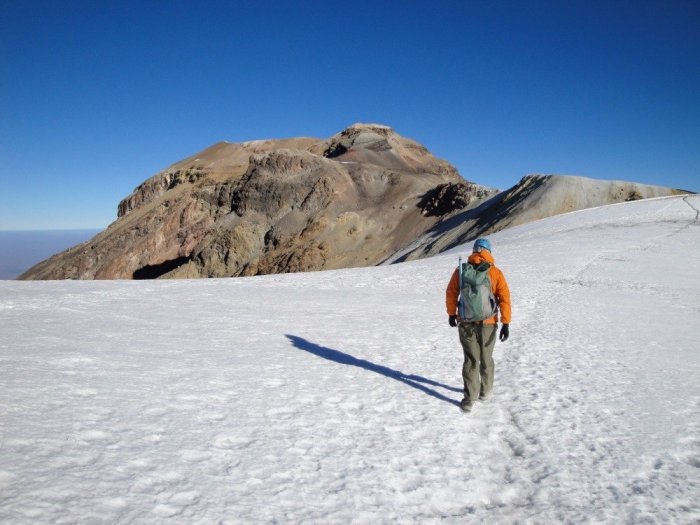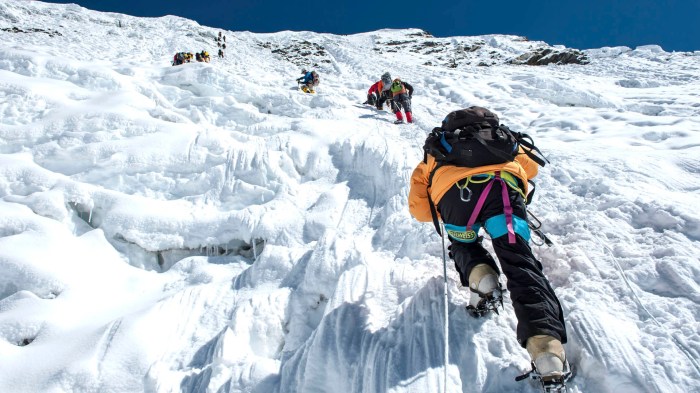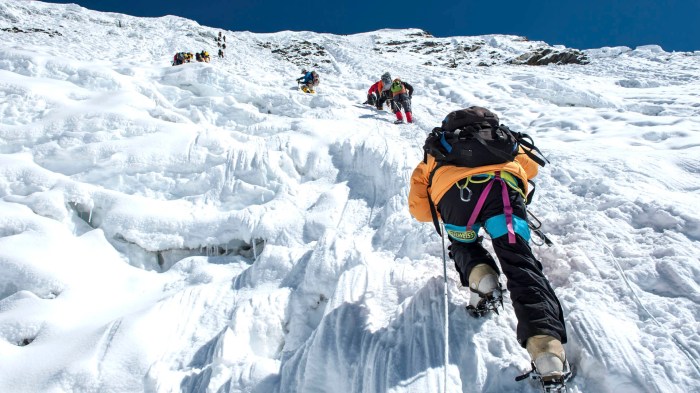Mountaineering in Mexico offers a thrilling adventure amidst breathtaking landscapes and challenging ascents. From the towering peaks of the Sierra Madre to the volcanic summits of central Mexico, the country boasts a diverse range of mountains that beckon climbers of all skill levels.
This guide provides an in-depth overview of mountaineering in Mexico, covering everything from popular destinations and routes to essential gear and safety considerations. Whether you’re a seasoned climber or planning your first ascent, this comprehensive resource will help you prepare for an unforgettable experience in the mountains of Mexico.
Overview of Mountaineering in Mexico
Mountaineering in Mexico has a rich history and tradition, with the country boasting some of the highest peaks in North America. The development of mountaineering in Mexico can be traced back to the early 19th century, when European explorers began to ascend the country’s mountains.
The first recorded ascent of Pico de Orizaba, the highest peak in Mexico, was made in 1848 by a group of German scientists.
Today, mountaineering is a popular activity in Mexico, with climbers from all over the world coming to experience the country’s stunning mountain scenery. The major mountain ranges in Mexico include the Sierra Madre Oriental, the Sierra Madre Occidental, and the Trans-Mexican Volcanic Belt.
The highest peaks in Mexico are Pico de Orizaba (5,636 m), Iztaccihuatl (5,286 m), and Popocatépetl (5,426 m).
The climate in Mexico varies depending on the region, but in general, the best time for mountaineering is during the dry season, which runs from November to April. During this time, the weather is generally clear and stable, with little rain or snow.
Popular Mountaineering Destinations in Mexico

Mexico boasts a diverse range of mountains and peaks, offering ample opportunities for mountaineering enthusiasts. From the towering summits of the Sierra Madre Occidental to the volcanic peaks of the Trans-Mexican Volcanic Belt, there are destinations to cater to all skill levels.
Here is a table showcasing some of the top mountaineering destinations in Mexico:
Mountain/Peak
| Name | Location | Elevation (m) | Difficulty Level | Unique Features |
|---|---|---|---|---|
| Pico de Orizaba | Sierra Negra, Puebla | 5,636 | Challenging | Mexico’s highest peak, known for its glaciers and steep slopes |
| Iztaccihuatl | Izta-Popo National Park, Mexico State | 5,286 | Moderate | A dormant volcano with three distinct peaks, offering scenic views of the surrounding valleys |
| Popocatépetl | Izta-Popo National Park, Mexico State | 5,426 | Challenging | An active volcano with a smoking crater, requiring special permits for ascents |
| Nevado de Toluca | State of Mexico | 4,680 | Easy to Moderate | An extinct volcano with a large crater lake, popular for hiking and camping |
| Cerro de la Estrella | Iztapalapa, Mexico City | 2,400 | Easy | A small but sacred mountain with historical and cultural significance, offering panoramic city views |
Mountaineering Routes and Trails
Mexico offers a diverse range of mountaineering routes and trails, catering to climbers of all skill levels and experience. These routes vary in length, difficulty, and elevation gain, providing ample opportunities for both novice and seasoned mountaineers to challenge themselves.
Choosing the Right Route
Selecting the appropriate mountaineering route is crucial for a successful and enjoyable experience. Consider your fitness level, technical skills, and experience when making your choice. Beginners should opt for shorter, less technical routes with moderate elevation gain. As you progress, you can gradually increase the difficulty and length of your climbs.
Popular Mountaineering Routes
Mexico boasts several renowned mountaineering routes, including:
- Pico de Orizaba:The highest peak in Mexico, Pico de Orizaba offers a challenging climb with an elevation gain of over 3,900 meters. It is suitable for experienced mountaineers.
- Iztaccíhuatl:Also known as “The Sleeping Woman,” Iztaccíhuatl is another popular mountaineering destination with an elevation gain of around 3,700 meters. It offers a moderate climb suitable for intermediate mountaineers.
- Nevado de Toluca:Located near Mexico City, Nevado de Toluca is a dormant volcano with an elevation gain of approximately 2,500 meters. It is a relatively easy climb suitable for beginners and families.
- Sierra Negra:This extinct volcano in the state of Puebla offers a scenic climb with an elevation gain of around 2,200 meters. It is a good option for intermediate mountaineers.
Equipment and Gear for Mountaineering in Mexico
Mountaineering in Mexico requires proper equipment and gear to ensure safety and comfort during the ascent. Here’s a comprehensive checklist of essential items to consider:
Choosing the right equipment is crucial for a successful and enjoyable mountaineering experience. Each item serves a specific purpose and contributes to the overall safety and efficiency of the climb.
Clothing and Footwear
- Moisture-wicking base layer
- Insulating mid-layer
- Waterproof and breathable outer layer
- Hiking pants or mountaineering trousers
- Sturdy hiking boots with ankle support
Clothing should be layered to regulate body temperature, protect from the elements, and allow for movement. Footwear should provide support, traction, and protection for the feet and ankles.
Backpack and Trekking Poles
- Backpack with adequate capacity for gear
- Hip belt and shoulder straps for weight distribution
- Trekking poles for stability and reduced strain on joints
A well-fitting backpack is essential for carrying gear comfortably. Trekking poles provide additional support and stability, especially on uneven terrain.
Climbing Equipment
- Climbing helmet
- Harness
- Carabiners and slings
- Belay device
Climbing equipment is necessary for safety when climbing technical sections or using ropes. It is crucial to ensure that all equipment is properly fitted and used.
First-aid Kit
- Antiseptic wipes
- Bandages
- Pain relievers
- Insect repellent
- Whistle
A first-aid kit is essential for treating minor injuries and emergencies. It should be easily accessible and contain basic medical supplies.
Navigation Tools
- Map and compass
- GPS device
- Altimeter
Navigation tools are crucial for staying on track and avoiding getting lost. Knowing how to use these tools is essential for safe mountaineering.
Safety Considerations for Mountaineering in Mexico
Mountaineering in Mexico offers a thrilling experience, but it also comes with inherent risks. Understanding and mitigating these hazards is crucial for a safe and successful expedition.
Altitude Sickness
Mexico’s high-altitude mountains can lead to altitude sickness, which occurs when the body struggles to adapt to the reduced oxygen levels. Symptoms range from mild headaches and nausea to severe cerebral and pulmonary edema.
- Ascend gradually to allow your body to acclimatize.
- Drink plenty of fluids to prevent dehydration.
- Carry altitude medication (e.g., acetazolamide) for emergency use.
Weather Conditions
Mexican mountains experience unpredictable weather, from intense sun exposure to sudden storms. Being prepared for all conditions is essential.
- Check weather forecasts before your climb and be prepared for changes.
- Wear appropriate clothing and footwear for all conditions.
- Carry a rain jacket, hat, and gloves for protection.
Wildlife Encounters
Mexico’s mountains are home to various wildlife, including venomous snakes and insects. Awareness and proper precautions are crucial.
- Stay on marked trails and avoid wandering into dense vegetation.
- Carry a whistle or bear spray for protection.
li>Be aware of your surroundings and watch for wildlife.
Navigation Errors
Getting lost or disoriented is a common risk in unfamiliar mountain terrain. Proper navigation is essential.
- Carry a map and compass or GPS device.
- Know how to use your navigation equipment.
- Stay on established trails and avoid shortcuts.
Acclimatization and Training for Mountaineering
Proper acclimatization and training are essential for successful mountaineering in Mexico. The high altitudes of many popular destinations can pose significant challenges to your body and mind.
To prepare for the demands of high altitude, it’s crucial to gradually increase your elevation over time. This allows your body to adjust to the decreasing oxygen levels and reduce the risk of altitude sickness. Consider spending several days at intermediate altitudes before attempting higher peaks.
Training Programs and Resources
In addition to acclimatization, a comprehensive training program can enhance your mountaineering performance. Focus on exercises that build cardiovascular fitness, strength, and endurance. Include activities like hiking, running, and weightlifting in your routine.
Consider consulting with a qualified mountaineering guide or trainer for personalized advice and training plans. They can assess your fitness level and provide tailored guidance to help you reach your goals safely and effectively.
Environmental Considerations for Mountaineering in Mexico

Mountaineering in Mexico offers breathtaking experiences, but it’s essential to minimize our impact on the fragile environment. Adhering to leave no trace principles, respecting wildlife and vegetation, and using biodegradable products are crucial for preserving the pristine beauty of Mexico’s mountains.
Leave No Trace Principles
Leave no trace principles guide mountaineers to minimize their impact on the environment. These principles include:
- Pack out what you pack in: Carry all trash and food scraps back to dispose of properly.
- Leave what you find: Avoid disturbing rocks, plants, or artifacts.
- Camp responsibly: Choose designated campsites and use fire rings if available. Minimize impact on vegetation and soil.
li>Respect wildlife: Observe animals from a distance and avoid disturbing their natural behavior.
Respecting Wildlife and Vegetation
Mexico’s mountains are home to diverse wildlife and vegetation. Respecting their habitats is crucial for maintaining the ecological balance. Avoid disturbing animals, and stay on designated trails to minimize damage to plants.
Using Biodegradable Products
Biodegradable products decompose naturally, reducing their environmental impact. Use biodegradable toilet paper, soap, and other personal hygiene items. Avoid using plastic or non-biodegradable materials that can harm wildlife or pollute water sources.
Mountain Huts and Refuges in Mexico
Mexico offers a variety of mountain huts and refuges to accommodate climbers and mountaineers. These facilities provide shelter, food, and other services to support mountaineering activities in different regions of the country.
The availability of mountain huts and refuges varies depending on the popularity and accessibility of the mountaineering destinations. Some huts are located in remote areas and require advanced planning and reservations, while others are more accessible and can be used as base camps for day hikes or short climbs.
Mountain Huts and Refuges in Mexico
| Name of Hut/Refuge | Location | Facilities and Services | Booking Information |
|---|---|---|---|
| Refugio de Piedra Grande | Pico de Orizaba National Park, Puebla | – Dormitories
|
Reservations required through the National Park Service |
| Refugio del Iztaccihuatl | Iztaccihuatl National Park, Mexico State | – Dormitories
|
Reservations required through the National Park Service |
| Refugio de La Joya | Popocatépetl National Park, Mexico State | – Dormitories
|
Reservations required through the National Park Service |
| Refugio de San Miguel | El Chico National Park, Hidalgo | – Dormitories
|
Reservations recommended |
| Refugio del Tepeyac | Izta-Popo Zoquiapan National Park, Mexico State | – Dormitories
|
Reservations required through the National Park Service |
Mountaineering Guides and Services in Mexico
Mountaineering in Mexico is a rewarding experience, but it can also be challenging. If you are planning to climb a mountain in Mexico, it is important to consider hiring a mountaineering guide or service. A guide can help you plan your trip, choose the right equipment, and stay safe on the mountain.There
Mountaineering in Mexico offers a diverse range of experiences, from challenging ascents to picturesque hikes. While the country is renowned for its high peaks and rugged terrain, it also boasts charming towns and historic sites. For those seeking a scenic drive in Europe, driving from London to Edinburgh offers a captivating journey through the rolling hills and vibrant cities of England and Scotland.
Back in Mexico, mountaineering enthusiasts can embark on expeditions to the iconic Pico de Orizaba, the country’s highest peak, or explore the lesser-known but equally stunning Sierra Madre Oriental.
are many mountaineering guides and services available in Mexico. You can find a guide through online directories, guidebooks, or word-of-mouth. When choosing a guide, it is important to consider their experience, qualifications, and reputation.Here are some tips for choosing a mountaineering guide in Mexico:
- Ask for recommendations from friends or family who have climbed in Mexico.
- Read online reviews of different guides and services.
- Interview potential guides to learn about their experience, qualifications, and safety record.
- Make sure the guide is certified by a reputable organization, such as the American Mountain Guides Association (AMGA) or the International Federation of Mountain Guides Associations (IFMGA).
Once you have chosen a guide, be sure to discuss your trip plans in detail. The guide can help you choose the right route, pack the necessary gear, and prepare for the challenges of the mountain.
Planning and Logistics for Mountaineering in Mexico
Thorough planning and meticulous logistics are paramount for successful mountaineering expeditions in Mexico. They ensure safety, efficiency, and compliance with local regulations.
Securing necessary permits, arranging reliable transportation, and booking accommodations in advance are crucial. Familiarizing oneself with local customs and regulations is equally important to avoid any misunderstandings or potential legal issues.
Permits and Regulations
- Obtain climbing permits from the relevant authorities, such as the National Park Service or local municipalities.
- Follow established trails and designated camping areas to minimize environmental impact and respect local regulations.
- Be aware of restricted areas and seasonal closures to ensure safety and avoid conflicts with wildlife or conservation efforts.
Transportation and Accommodations
- Plan transportation to and from the trailhead, considering public transportation, private vehicles, or guided tours.
- Book accommodations in advance, especially during peak season, to secure availability and avoid last-minute surprises.
- Consider staying in local guesthouses or homestays to support the local economy and experience Mexican hospitality.
Local Customs and Considerations, Mountaineering in mexico
- Respect local customs and traditions, such as asking permission before entering private property or taking photographs.
- Be mindful of noise levels and avoid disturbing the tranquility of the natural surroundings.
- Learn basic Spanish phrases to facilitate communication with locals and enhance the overall experience.
Conclusive Thoughts
Mountaineering in Mexico is an exhilarating and rewarding experience that offers stunning views, physical challenges, and a deep connection with nature. By following the tips and advice Artikeld in this guide, you can safely and successfully navigate the mountains of Mexico and create memories that will last a lifetime.
Key Questions Answered
What are the major mountain ranges in Mexico?
The Sierra Madre Occidental, Sierra Madre Oriental, and Sierra Madre del Sur are the three major mountain ranges in Mexico.
What is the highest mountain in Mexico?
Pico de Orizaba (Citlaltépetl) is the highest mountain in Mexico, with an elevation of 5,636 meters (18,491 feet).
What is the best time of year to go mountaineering in Mexico?
The best time to go mountaineering in Mexico is during the dry season, which runs from November to April.
What are some essential items to pack for a mountaineering trip in Mexico?
Essential items for a mountaineering trip in Mexico include: backpack, trekking poles, climbing equipment, first-aid kit, navigation tools, clothing and footwear appropriate for the conditions, and plenty of food and water.



